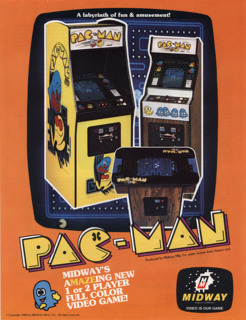Pac-Man Fever!
There can be no better example of this situation than the arcade game Pac-Man. My friends and I would shuffle into the arcade and huddle around the machine like it was our religion, each of us fighting for who goes first and who goes next. Pac-Man was the best thing going, and we all wanted a piece of it as often as possible. There were no home game versions that were up to snuff to replace the need to make a trip to the mall or the Pizza Hut to get a whiff of what Pac-Man had to offer. We all happily suffered from Pac-Man Fever!
Pac-Man has a very basic formula. It consists of a hungry yellow ball, with an acute angle for a mouth, named "Pac-Man". HIs goal is to eat up all the pellets available in a large maze. As he does this, he is pursued by monsters which have the specific job of stopping Pac-Man in his tracks. Each monster had a name, and characteristics which the player would have to keep in mind as he guided Pac-Man through the maze to complete his goal. "Blinky" (a.k.a. "Shadow") is the red monster, and his strategy is to target Pac-Man by finding the shortest path to where he currently is, and do it with great speed. "Pinky" (a.k.a. "Speedy"), the pink monster, attempts to counter Pac-Man by catching up to him quickly and targetting himself to collide with Pac-Man face-to-face. "Inky" (a.k.a. "Bashful"), the blue monster, has the specific goal of cutting of Pac-Man's escape route. Finally, "Clyde" (a.k.a. "Pokey"), the orange monster, is the last to come out of his hide-out to pursue, but once he catches up with Pac-Man, he retreats to the corner.
On each maze screen, there are four power pellets, which have the effect of putting the monsters into a vulnerable state, which is indicated by each monster turning blue. This allows Pac-Man to catch up with and devour the suits covering these creatures, leaving them with nothing but their eyes to return to their lair and resuit up to return and aggressively pursue Pac-Man once again. This effect lasts only for a certain amount of time, and indicates that it is about to expire with the ghosts flashing between blue and white. Once a board is wiped clean of food, Pac-Man is transported to a board with the exact same maze, and a new set of dots. Each time Pac-Man completes a board, the monsters become quicker and more aggressive, and the effect of the power pellets becomes shorter and shorter, until ultimately the have no affect at all. Pac-Man has one escape tunnel on each side of the screen. Going into one exits you to the other side of the screen. Pac-Man can go through these as quickly, while the ghosts have to slow down when entering the tunnel. These are a godsend in the heat of the moment, because if Pac-Man is so much as touched by a monster, he is literally turned inside out and disappears. One of the few complaints is that on the default setting, Pac-Man moves slowly, making the game near impossible to keep going more than a few minutes. This is fixed by a simple switch setting, which speeds him up significantly, and many arcades did made this setting to increase the popularity of the game among their customers.
Pac-Man starts with three lives, and can gain a fourth life at 10000 points (15000 or 20000 depending on the switch settings). The game is very much centered on racking up points, as so many arcade games were at the time. Each pellet Pac-Man eats is worth 10 points, while each power pellet is worth 50. Devouring the monsters after eating a power pellet has a growing point-scale for each ghost: first 200 points, then 400, then 800, then finally 1600. Additionally, there are two chances each board when a bonus item will appear in the middle of the board temporarily. Pac-Man can eat these if he gets to them before they disappear and increase his point-score. Depending on the item, the bonus can be anything from 100 and 5000 points.
What attracted me to this game the most was its very solid and professional presentation. Many arcade games at the time Pac-Man was released were vector games with little variety or color, or black and white shaded games with screen overlays to add color. Many games were choppy and didn't perform well. Pac-Man was a game that moved beyond these trends. It was vibrant, colorful, and had a presentation uncommon for the time. It was a game that entertained the player rather than just occupying his time. The sound effects had a techno-computo-playful sound; I can still hear that brilliant introduction music, the "waka-waka-waka" sound of Pac-Man chomping away at pellets, and the clever sound effects as he turned inside out after capture. The enemies had specific attack patterns that gave the game some depth and a difficulty level that was intelligent rather than random. The icing on the cake are the three animated cut-scenes available after a certain number of boards were cleaned. They provided a nice pause from the solid action, as well as some cleverly staged comic relief.
This game has the distinction of being the most successful coin-operated arcade game in history according to the "Guiness Book of World Records". It's little wonder this game was so popular. It was a significant milestone in the development of the gaming genre, and the start of a series of arcade sequels which seemed to improve on the overall formula. Even after all these years, the game still holds its own. It has a timeless quality that never seems to grow old. I fully expect that when people are settling on Mars, they will still be playing Pac-Man, and that's something few games can say.

